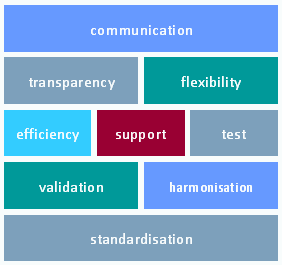CEBS Why is XBRL recommended to be used?
From XBRLWiki
ALL TOPICS ARE STILL ON DISCUSSION!
(To be completed)
Contents |
Introduction
This document intends to clarify why the European Banking Authority (formerly Committee of European Banking Supervisors) recommends the use of XBRL since 2005. Eurofiling project is an open joint initiative of the XBRL Operational Network of the European Banking Authority in collaboration with XBRL Europe, as well as stakeholders as banks, solutions providers, academy and individuals. Ignacio Boixo and Katrin Schmehl, co-coordinators of the XBRL Operational Network, chronicle the search for a common reporting taxonomy in Europe and the role of XBRL in the new Eurofiling initiative, in the article Collaborative Development of I.T. Supervisory Frameworks
Historical background
In the end of 2004 the CEBS COREP Operational Network provided a set of very complex but harmonised European tables summarising the implementation of Basel II pillar I for Europe to a group of IT experts from different European national banks to create a common electronic format.
Their requirement: the common European electronic data format should represent the defined Excel tables. The set of Excel tables defined reportable financial business data, validation rules, specific views on the data and labels defined first in English but later in several European languages.
We discussed three different alternatives XML, SDMX and XBRL. The last one was in 2004 an upcoming standard but at this time not yet widely used. Because SDMX and XBRL already provided a frame for the report of financial data and both were standardised, SDMX by ISO and XBRL by industry, a proprietary and in-house developed XML format was no longer considered.
The usage of a standard allows to access best results of science and technique and reduces the efforts for the creation of own probably poorer solutions. With each new member adopting a standard the spreading of this technology increases and eases the interoperability. A standardisation increases the efficiency and minimises the market risks.
SDMX provides a good possibility to cover the multidimensionality of the COREP tables whereas XBRL supports multi languages, a possibility to define the presentation and it also included support for validations but it missed a support for multi dimensions.
In February 2005 a group of around fifty volunteers including several XBRL experts met to discuss how XBRL could be extended to support this missing functionality. A solution was found and the standard was extended accordingly and finalised right before the publication of the first COREP XBRL taxonomy. This new functionality made XBRL quite more attractive and now 5 years later the adoption of XBRL increased significantly worldwide http://www.xbrlplanet.org.
Nevertheless XBRL is just a recommendation several European countries participate in the harmonisation process of the CEBS and adopted XBRL as reporting format. Distribution in Europe To join efforts and to exchange experiences the CEBS XBRL Network organise workshops twice a year.
Benefits of XBRL
communication
- Single, XML-derived reporting standard
- Detailed understanding of data model
- Interoperability with existing XML schemas
- Several languages can be incorporated
transparency
- Comparability of data across Europe
- Possibility of a faster exchange of information with regard to the financial crisis
- Versioning will be supported
- Open source
flexibility
- XBRL is extensible --> adaptation to national discretions
- Modularised architecture of XBRL
- Structural changes in the data are not reflected in the instance
efficiency
- Reduction of cost and time along the supply chain for financial information
- Eases the possibility of automation by supporting
- automated error detection
- versioning
- Time and cost saving for the reporting entity because of early responses
- One common format is more cost-effective than a numerous number of different proprietary formats
support
- Shifting of manual support to automated processes
- In-house developed systems can be replaced by standardised market solutions
test
- XBRL reports can be easily tested before submission
- Transition process of a reporting entity could be supported by providing a test platform
validation
- Validation via standardised approaches
- Extensive possibilities for formula definitions
- Summarisation of formulas --> reduction of the amount of formulas
- No need for specific in-house solutions for the reporting entities
harmonisation
- Approach is in line with the reconciliation for an harmonised reporting in the EU
- Uniform validation rules can be used
- Allows cooperation on a unified data basis (i.e. Colleagues of Supervisors)
- Enables an effective analysis of cross-border financial institutions
standardisation
- Assures competitive capacity
- Eases the exchange with other European countries
- Enables the use of standardised technology
- Eases interoperability
- Minimises risks
- No other standardised business reporting standard exists
...but XBRL is too complex
This concern is often mentioned and should be answered also with an analogy. Let's suppose you are a financial expert and you want to share your analysis with your colleagues in your company. Usually you would summarise these information in Excel sheets and order the figures in a nice tabular way so that they can be easily read and understand by your colleagues. You might also include some formula to summarise data and ensure that the validation is correct. Then you send this Excel file to your colleagues. The file will be opened in Excel, presented in the way you have designed it and validated against your formulas. Let's suppose further that a consultant comes to your company and offers to analyse your processes and he comes to the conclusion that you should prepare your analysis in Notepad and send a simple text file to your colleagues. The only obstacle is that you have to implement your own presentation and also the validation. Your colleagues have to do the same or they just try to read the content in the Notepad style.
You think this is absolutely nonsense? No consultant would propose this stupid idea? You are right but if you replace Excel with XBRL and put in a proprietary XML for Notepad you are sitting right in front the same topic. What is more complex? Learn how to use XBRL and use the XBRL standard software provided by the market or develop an numerous amount of applications for you as well as for your counterparties that generate the presentation and validation on basis of your proprietary XML structure?



